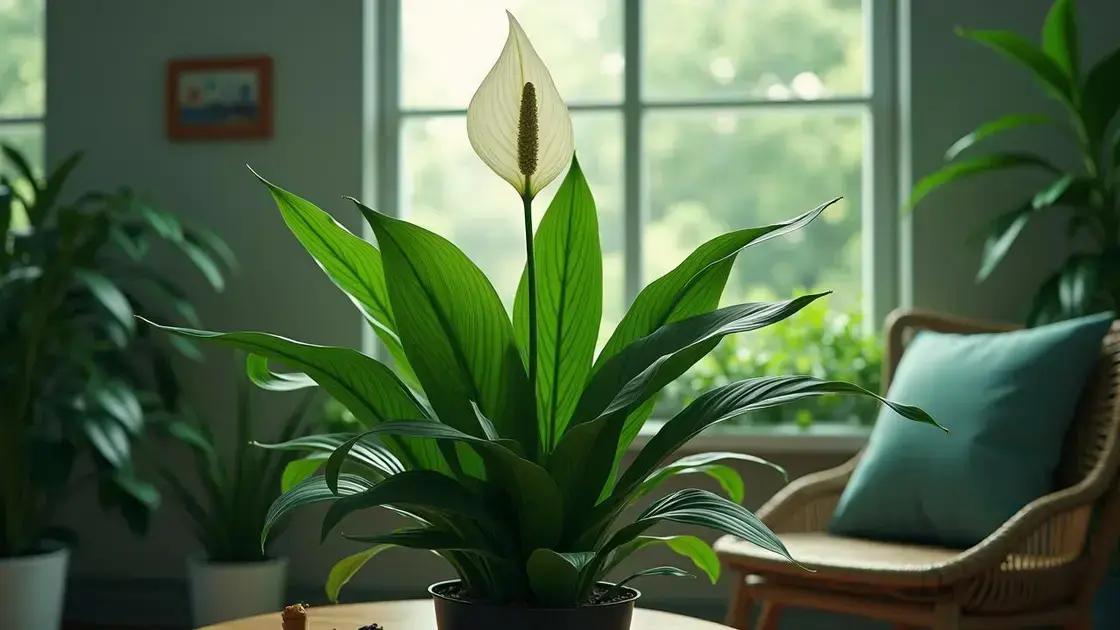How to Take Care of a Peace Lily Plant Indoors: 5 Essential Tips
How to take care of a peace lily plant indoors is often a question for those wanting that vibrant green touch in their homes. These plants are not just pretty; they bring a refreshing vibe and purify the air. To thrive, peace lilies need specific care, including a deep understanding of their watering needs and ideal light conditions. Let’s dive into how to ensure your peace lily flourishes indoors.
Table of Contents
ToggleUnderstanding the watering schedule for peace lilies
Understanding the watering schedule for peace lilies is crucial for maintaining their health and vibrancy. These beautiful indoor plants thrive in specific conditions, and their watering needs are vital to their growth. Following the right watering schedule will help prevent issues like root rot or wilting.
- Observe the plant’s needs by checking the soil moisture regularly.
- Water your peace lily when the top inch of soil feels dry to the touch.
- Use room temperature water to avoid shocking the plant.
- During peak growing seasons (spring and summer), ensure you water more frequently than in fall and winter.
How much water should peace lilies receive?
On average, a peace lily requires about 1-2 cups of water every week, depending on the humidity and temperature of your space. Here are some additional tips:
- Drainage is key: Always use pots with drainage holes to prevent standing water.
- Humidity matters: Maintain a humid environment; consider misting the leaves or placing a humidity tray nearby.
- Signs of under-watering: Yellow leaves and drooping may indicate a lack of moisture.
- Signs of over-watering: Brown tips on leaves and a soggy feel to the soil could signal excess water.
Common questions about watering peace lilies:
How often should I water? Watering every 7-10 days is typically sufficient but will vary with environmental conditions.
Can peace lilies survive in low light? Yes, they can, but be mindful that less light means less water evaporation, which may affect your watering schedule.
For more comprehensive plant care tips, consider exploring indoor gardening techniques.
Optimal soil and fertilization for indoor plants

Optimal soil and fertilization for indoor plants is essential for the healthy growth of your peace lily. Choosing the right soil mix and fertilization schedule ensures that your plant receives the necessary nutrients to thrive. Let’s explore the best practices for creating an ideal environment.
What type of soil is best for peace lilies?
A well-draining soil mix is crucial for peace lilies, as they are sensitive to overwatering. Here are some options:
- Commercial potting mix that contains perlite or vermiculite for aeration.
- A DIY soil mix consisting of equal parts of peat moss, perlite, and pine bark.
- Moss-based mixes that retain moisture while allowing drainage.
How to fertilize peace lilies effectively?
Fertilizing your peace lily is necessary during the growing season to promote vibrant growth:
- Use a balanced fertilizer with an NPK ratio of 20-20-20.
- Feed every 6-8 weeks from spring to early fall.
- Reduce feeding during the dormant season (fall and winter).
- Always follow the manufacturer’s instructions to avoid over-fertilization.
Remember to flush the soil with water every few months to remove any salt buildup from fertilizers.
Common questions about soil and fertilization:
Can I use garden soil for peace lilies? It’s not recommended, as garden soil may retain too much moisture and lack the necessary nutrients.
How do I know if my plant needs fertilization? If your peace lily’s growth has slowed and leaves are yellowing, it may need nutrients.
For more detailed plant care guidance, consider exploring indoor gardening techniques.
Choosing the right sunlight exposure for peace lilies
Choosing the right sunlight exposure for peace lilies is essential for their thriving health and beauty. Peace lilies prefer indirect light and can suffer in too much direct sunlight or too little exposure. Finding that balance is key to a flourishing plant.
Why is sunlight important for peace lilies?
Sunlight plays a critical role in photosynthesis, allowing the plant to generate energy. Here are some factors to consider:
- Peace lilies thrive in bright, filtered light.
- Direct sunlight can scorch the leaves, leading to brown edges.
- Insufficient light results in leggy growth and fewer blooms.
How to determine the best light conditions?
Here are steps to ensure your peace lily gets the right amount of light:
- Location: Place your peace lily near a north or east-facing window for optimal indirect light.
- Rotation: Rotate the pot every few weeks to ensure even exposure to light.
- Observation: Watch for signs of too much or too little light, such as leaf discoloration or droopiness.
Consider using sheer curtains to diffuse strong sunlight, providing a gentle glow that nourishes the plant.
Common questions about light exposure:
Can peace lilies survive in low light? Yes, but their growth may slow, and they may produce fewer flowers.
How can I tell if my plant is getting too much light? Yellowing leaves and fading color can indicate excess sunlight.
For further guidance on optimally caring for your indoor plants, check out exploring indoor gardening techniques.
In conclusion
Caring for peace lilies is a rewarding experience that enhances any indoor space. By understanding their watering needs, providing optimal soil and fertilization, and ensuring the right sunlight exposure, you can create a thriving environment for your plant. Remember to observe your peace lily closely and adjust care practices as needed. For additional insights and helpful resources, explore tips on enhancing your indoor garden.

